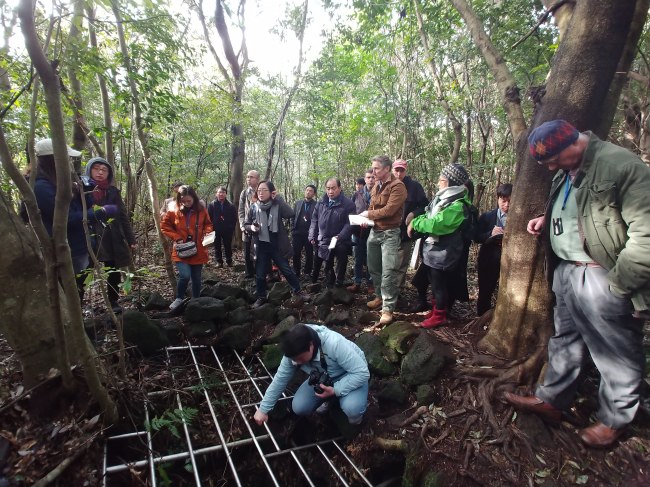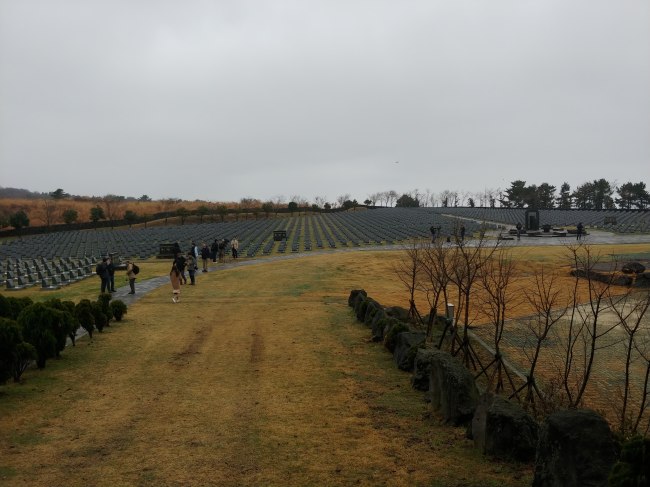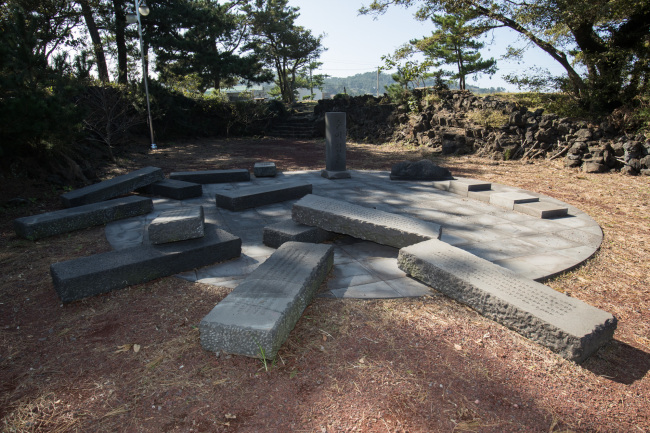Jeju remembers
Jeju Island’s Dark Tours commemorate those slaughtered in the 4.3 massacres
By Yoon Min-sikPublished : March 29, 2018 - 15:51
The narrow, muddy hike up Dongbaekdongsan is full of branches and leaves hindering your every step. You get irritated, struggling to keep up with the rest of your group, before you realize this was the path dozens of villagers from Seonheul-ri took to reach where they believed would be a safe haven from death.
The harrowing moment comes when you realize you are headed to a graveyard of 20 men and women -- elderly and children -- slaughtered, on a night in 1948 by soldiers who had sworn to protect them.
Dottle Cave in Seonheul-ri, Jeju Island, is one of several caves where islanders hid from the massacres by the South Korean military 70 years ago. It is part of Jeju Dark Tours that commemorates those killed in one of the worst abuses of state power in the country’s history.
The harrowing moment comes when you realize you are headed to a graveyard of 20 men and women -- elderly and children -- slaughtered, on a night in 1948 by soldiers who had sworn to protect them.
Dottle Cave in Seonheul-ri, Jeju Island, is one of several caves where islanders hid from the massacres by the South Korean military 70 years ago. It is part of Jeju Dark Tours that commemorates those killed in one of the worst abuses of state power in the country’s history.

Simply known as the Jeju Uprising, Jeju Massacre, or 4.3 Incident, referring to April 3, the incident does not yet have an official name.
The tragedy
In 1948, Korea had been freed from the shackles of Japanese colonialism but not from the ideological divide that ails Koreans to this day.
On March 1, 1947, tragedy struck during a commemoration of the March 1st Movement. A mounted policeman -- allegedly unwittingly -- injured a child with his horse, sparking off a protest by an angry mob. The police, mistaking it as an attack against them, shot and killed six people and injured six others.
Instead of apologizing to the public, the authorities cracked down on the protesters, leading to further furor and a nationwide general strike on March 10.
The US Army Military Government in Korea, the official ruling body of the southern half of the Korean Peninsula until Aug. 15, 1948, defined the movement as pro-communist and answered with a firm hand.
The authorities labeled the southern island a “Red Island,” arresting thousands for supposed pro-communist activities.
An armed revolt on April 3, 1948 was actually not a major incident in the grand scheme of things, but led to a horrifying massacre that took the lives of nearly 30,000 -- mostly civilians -- from October 1948 to March 1949.

“Back then there were a lot of people up in the mountains who came down to the village at night and put leaflets on the walls. In the morning, policemen would beat people up for it,” said Ko Wan-soon, 80, who was a 9-year-old living in Bukchon-ri in 1949. The people up in the mountains referred to armed rebels.
“One day, adults were clamoring over something and I heard that the mountain folks shot and killed two soldiers. They carried the bodies to the police station, and (the policemen) shot them all to death, except one who was a family member of a policeman,” she said.
What followed was one of the largest killings in the Jeju Incident.
“My family was dragged out to a school playground, where they told us all to kneel down. Then I heard shots being fired and people collapsing. I crawled like an ant until I came across something. Blood all over the ground, and a baby looking for mommy.
“My baby brother was screaming on the back of my mother. He went quiet after a soldier came along and struck him twice in the head.”
It was by happenstance that she managed to survive. As she and her family were waiting for what seemed the inevitable, a jeep came along to order the men to stop shooting.
The town of Bukchon-ri was no more, as houses were destroyed and over 300 perished by machine gun fire.
Commemorating the victims
There have been attempts to make amends, such as former President Roh Moo-hyun formally apologizing in 2003 for the massacre on behalf of the South Korean government. In 2000, His predecessor Kim Dae-jung signed a plan to acquire land on Jeju Island to create what is now the Jeju 4.3 Peace Park. The memorial hall and the park opened in 2003.
According to Kim Nam-hoon, a staffer of Jeju Dark Tours, support for projects related to the 4.3 Incident has been minimal under conservative governments. Officials of groups related to the project believe it is because the massacre was carried out under South Korea’s founding President Rhee Syng-man, a revered figure among right-wingers.

With liberal President Moon Jae-in taking office in 2017, a multibillion won project to ensure the 4.3 Incident’s place in history has been launched, Kim said.
Jeju 4.3 Peace Park represents such efforts.
Next to an altar dedicated to the victims are mounds of empty graves, of civilians who were arrested and sent to prison on the mainland, never to return.
Jeju Dark Tours invite participants to visit the memorial halls and sites related to the 1948 massacre. This includes the Peace Park, the aforementioned Dottle Cave, Banmot Cave on the same mountain where people hid and Bukchon-ri where hundreds were slaughtered.
The Neobeunsung Sacred Memorial for Victims of Jeju 4.3 stands in the town of Bukchon in memory of the victims. Monuments stand on fields where the victims awaited their doom. The stones are deliberately scattered all over the place to symbolize their bodies.
The memorial provides commentaries for those who wish to visit the massacre sites or watch videos related to the incident. One can call 064-783-4303 for inquiries.
Another place for the Dark Tours is the house of Jin A-yeong, a woman who was shot in the face during the 4.3 Incident and lost her chin. Jin, who died in 2004, was known as the “cotton cloth lady” for the cotton cloth she wore around where her chin was supposed to have been.
Ongoing efforts
A group of bereaved families are now asking the US government to admit some responsibility for the massacres. A majority of the killings occurred after the US military relinquished governance of South Korea, but they believe that it is still responsible, as the April 3 uprising occurred during the US military rule and it had a profound influence over the fledgling South Korean government.
Yang Yoon-kyung, the chairman of the Association for the Bereaved Families of 4.3 Victims, said that the group seeks to collect 100,000 signatures of people demanding the US acknowledge responsibility for the incident, and deliver them to the South Korean and US governments, along with the UN.
Officials of the Jeju 4.3 Peace Foundation are now pushing to revise the special law on the investigation of the 4.3 Incident and its victims, passed under the Kim Dae-jung administration in 2000. The revision centers on providing compensation for the victims.
By Yoon Min-sik
(minsikyoon@heraldcorp.com)







![[From the Scene] Monks, Buddhists hail return of remains of Buddhas](http://res.heraldm.com/phpwas/restmb_idxmake.php?idx=644&simg=/content/image/2024/04/19/20240419050617_0.jpg&u=20240419175937)








![[From the Scene] Monks, Buddhists hail return of remains of Buddhas](http://res.heraldm.com/phpwas/restmb_idxmake.php?idx=652&simg=/content/image/2024/04/19/20240419050617_0.jpg&u=20240419175937)

![[KH Explains] Hyundai's full hybrid edge to pay off amid slow transition to pure EVs](http://res.heraldm.com/phpwas/restmb_idxmake.php?idx=652&simg=/content/image/2024/04/18/20240418050645_0.jpg&u=20240419100350)

![[Today’s K-pop] Illit drops debut single remix](http://res.heraldm.com/phpwas/restmb_idxmake.php?idx=642&simg=/content/image/2024/04/19/20240419050612_0.jpg&u=)